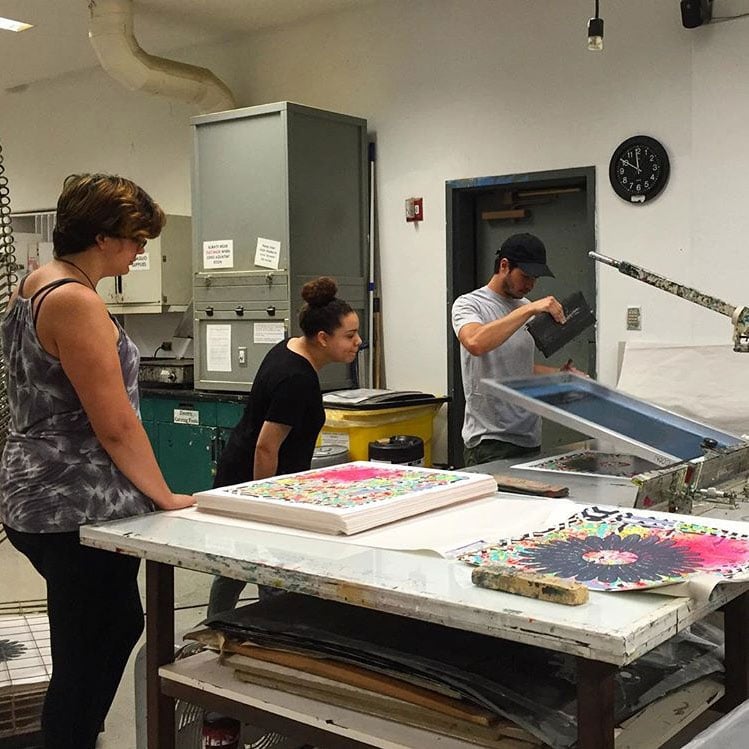Art World
Citing Crumbling Ceilings and Absent Faculty, Columbia University Art Students Demand a Refund
Students say the ceilings are caving in on them and the top professors are on sabbatical.

Students say the ceilings are caving in on them and the top professors are on sabbatical.

Taylor Dafoe

Students in Columbia University’s visual arts MFA program are demanding a tuition refund for the current school year, citing dangerously dilapidated facilities, a faculty shortage, and rising tuition rates.
The two on-campus buildings that house student studios have seen better days, particularly Prentis Hall. A combination of poor insulation and exposed heat pipes have left some studios unusually cold while others are dangerously warm, say students, who have documented temperatures at above 85 degrees and below 40. One student even says his computer melted in his studio.
Works of art have also been irreparably damaged at times, both because of temperatures and flooding. Pieces of limestone have fallen from the building’s ceiling, including one chunk so large that students say it could have been fatal had the artist been in the space at the time. After that incident, the school installed nets on every ceiling—a process that took most artists out of their studios for several days. Since then, the building has been, as one student put it, a “constant construction site.”
Another complaint is that the small faculty has been stretched too thin. Several professors, including Sanford Biggers, Shelly Silver, and Tomas Vu, are on sabbatical—breaks for tenured teachers that in many cases had been delayed in the past because of short-staffing. In January, the school’s longtime director of the photography program, Thomas Roma, departed following numerous allegations of sexual misconduct. No teachers have been brought in as replacements. Students complain that they haven’t gotten to work with—or even meet—some of the notable artists that drew them to the school in the first place. (Students interviewed for this piece did note, however, the quality of the professors that are currently teaching in the program.)

Students working in the LeRoy Neiman Center for Print Studies at Columbia University. Courtesy of the LeRoy Neiman Center for Print Studies.
These problems are exacerbated by the higher-than-average tuition Columbia students pay. Tuition and fees for the current year is $63,961—nearly double that of many other competitive MFA programs. That figure has risen steadily over the past several years, while the number of scholarships has gone down. The school’s visual arts class of 2018 estimated that their collective debt was upwards of $1 million.
“It’s like a yearly ritual,” said one current student who asked to remain anonymous. “Every spring, as people are starting to graduate, they meet with administration to complain about the program’s resources and facilities. The administration says they’ll address those complaints in a couple of months, and then the students graduate. This is something that Columbia does constantly. They make promises, then wait for people to leave or graduate so they don’t have to fulfill them”
But this year was slightly different. The situation with Roma led to a string of town-hall meetings and larger conversations with the student body about what they felt were the program’s shortcomings. Students brought a list of complaints to the dean of the School of the Arts, Carol Becker, on February 1. After that, the faculty also sent a letter to school administrators asking them to address the students’ concerns.
On April 5, the battle escalated when the students met with John Coatsworth, Columbia’s provost, and David Madigan, dean of the faculty of arts and sciences. They presented a letter listing their concerns about the state of studio facilities, faculty absences, and inadequate funding. It stated a series of actions they wanted the school to take in response, including tuition remission for all current students.
“Should the School find it impossible to run this program, we are prepared, as students and alumni, to take all proper measures to ensure adequate compensation,” read the letter, signed by 51 of the 54 students in the 2018 and 2019 classes. In response, the school told the students that they would be reimbursed for damaged works and lost studio time, but they would not receive a refund in tuition.

Columbia University School of the Arts’s new Lenfest Center for the Arts. Courtesy of Columbia University.
“The facilities problems in Prentis Hall are regrettable, and the University continues to aggressively explore and implement remedies for the affected Visual and Sound Arts Students,” a representative for the school said in a statement to artnet News. “To that end, we have compensated students in studios experiencing excessive heat and also those students whose artwork was damaged. We also are developing longer-term solutions to ensure that the studio space so important to Columbia’s talented artists is of the high caliber they deserve.”
The students have not been satisfied with these efforts, however.
“The Columbia administration wants to invest in the appearance of the arts—or invest in the appearance of investing,” says Meg Turner, a student from the class of 2018. “But it’s not actually listening to the needs of students, such as providing functional facilities and faculty that aren’t running around, constantly dealing with things like floods, damaged work, or canceled studio visits due to 90-degree temperatures.”
For many years, Columbia has been listed among the top MFA programs in the world. In 2016, a survey by artnet News concluded that it was the third most influential art school in the world. But exorbitant tuition rates and recent scandals risk putting school’s reputation in jeopardy.
“Many of us are up for teaching positions, some of them at Columbia, some of them at other places,” says a student in the 2018 class who asked to remain anonymous because of her employment situation. “I need that teaching position because now I have to pay off my loans.”